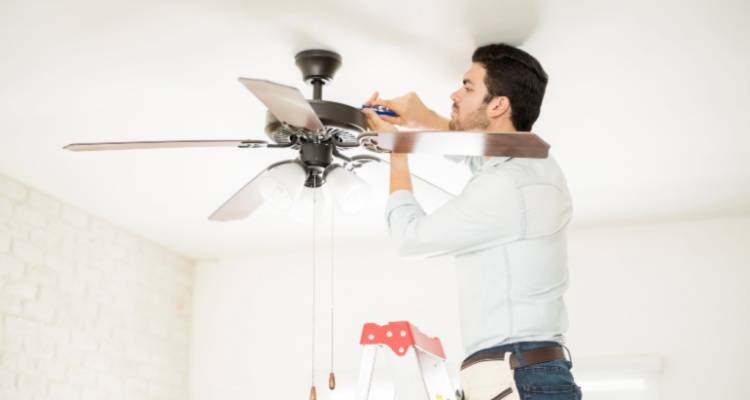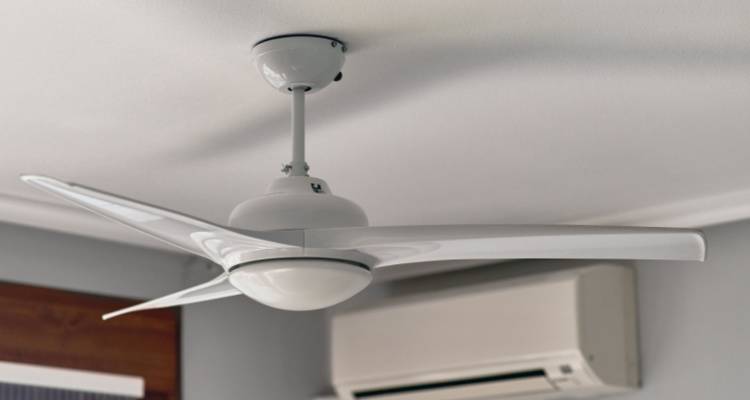Installing a Ceiling Fan Ahead of Hotter Weather
After a long, tough winter for many with rising heating costs and bouts of snowfall, the warm, sunnier days of summertime are nearly here. However, given just how warm it got last summer, many households are considering having the right ceiling fan installed ahead of the hotter weather.

In this article, we’ll discuss the various types of ceiling fans you’ll want to consider and their advantages.
Let’s dive in!
Types of Ceiling Fans
There are two primary ways of categorising ceiling fans: design and style. Since we are concerned primarily with the practicality of ceiling fans in this piece, we’ll mainly discuss design.
However, we’ll also look at style options toward the end of this section.
Regular Ceiling Fans
Standard ceiling fans tend to come with 4-5 blades and spin at a regular rate whenever switched on. These fans may or may not have a light built into the centre.
In most cases, they are extended down using a downrod (i.e., metal pipe connecting the fan’s motor housing and the mounting brackets). The use of a downrod makes standard ceiling fans well-suited to flat and sloped ceilings.
One of the key advantages of a standard ceiling fan is that it’s likely to be more affordable than say a dual-motor ceiling or smart ceiling fan.
Dual-motor Ceiling Fans
Alternatively, you may be interested in a dual-motor ceiling fan which uses a central motor housing fitted with two horizontal rods. Each of these rods works with an adjustable fan head.
One of the core advantages of dual-motor ceiling fans is that you can set each fan to a specific speed. That way, you can determine how breezy each side of the room should be. All in all, dual-motor ceiling fans are great for increased customisation.

While dual-motor ceiling fans are most commonly found in commercial/public spaces, they’re still worth considering for homes, especially if you have a large space where they’d make sense (e.g., a large open kitchen space). Dual-motor ceiling fans can come with lights in the centre or without.
One downside of dual-motor ceiling fans is that their design may be seen as a little quirky to some, and thus, they may or may not be your cup of tea.
Smart Ceiling Fans
This is one of the most modern design options on the market. Nowadays, it’s possible to purchase smart ceiling fans that can be controlled remotely via a smartphone or tablet.
Along with remote in-the-moment control, it’s often possible to set a schedule for when your ceiling fans should operate. Some also come with adaptive learning features that can tell when they should turn on based on the times you tend to be home.
If you’re considering a smart ceiling fan, we recommend looking into a range of options to see which ones fit your budget best and come with the sort of smart features you’re looking for.
Flush-mount Ceiling Fans
Flush-mount ceiling fans (a.k.a., low-profile ceiling fans or hugger fans) are designed for use in rooms/homes with relatively low ceiling heights. If you have a ceiling that is 8 ft tall or less (or approx. 2.4 metres or less), you’ll want to consider a flush-mount ceiling fan.
Rather than employing a downrod, flush-mounted ceiling fans are fitted directly onto their mounting brackets.
Outdoor Ceiling Fans
If you have a suitable outdoor space for a ceiling fan installation, the good news is that durable, sturdy ceiling fans exist that are specifically designed for outdoor installations. These are perfect for those who want to make the most of a patio, lanai or decking with a roof.

Just be sure that the outdoor ceiling fan is safe to add to the roof in terms of the roof’s load-bearing capacity. Consult a professional if you have any doubts. A professional will be needed to perform the installation after all.
What About Styles?
As promised, let’s briefly look at some of the best ceiling fan styles to consider ahead of the hotter weather.
Some of the most notable styles include:
- Modern - Sleek style often with warm neutral colours.
- Rustic - Offer a natural, countryside vibe.
- Traditional - Tend to come with rich designs, contrasting modern ceiling fan designs.
- Industrial - Style largely inspired by 21st century machinery and often utilise standout features (e.g., smooth wood finishes and blades resembling propellers).
- Farmhouse - Quintessentially rural with a look that doesn’t go out of style.
Hiring an Electrician
You’ll need to hire a professional electrician to install a ceiling fan. Electricians tend to charge somewhere in the region of £50 to £100 per hour (depending primarily on where you live).
Therefore, since the work should take an hour or less, the total cost of installation will likely be £50-100 + the cost of the ceiling fan itself.
Ceiling fan costs can vary widely, with some costing just £100 or less and some smart ceiling fans costing around £800 to £1,000.
When looking for the right electrician for the job, try to get quotes from three professionals before making a decision. Weigh up their pricing, previous experience and any online feedback from previous customers they have will help you make an informed choice and hopefully get good value for money.
Last updated by MyJobQuote on 24th April 2023.







